Transitional employment services - phase 2: evaluation
Evaluation of the delivery process and outcomes of Work First Scotland (WFS) and Work Able Scotland (WAS), collectively known as transitional employment support (TES) services.
2. Customers' Service Experience
2.1 Introduction
This chapter presents a detailed summary of the characteristics of WFS and WAS customers in terms of basic demographics, employment status and history, health conditions, benefits receipt, and their service participation.[11] The sample combined 665 customers who took part in the wave 1 phone survey and said that they were happy to be re-contacted and 638 contacts from the original wave 1 sample that were not used in that survey. As a result, while it is not a formal longitudinal survey design, the research has been able to compare responses between survey waves and reported these where they are statistically significant. Full details are included in Appendix 2.
2.2 Key findings
For WFS customers:
- Forty-one per cent were in work in wave 2, an increase from 30% in wave 1. More than half (51%) of those aged 16 – 34 were in work in wave 2.
- Those who reported that they have no disabilities (58%) were more likely than those with mental (33%) or physical (37%) disabilities to be working.
- Over half (55%) of customers felt that the support they had received had helped them 'a great deal' in moving into work, with over two thirds (69%) agreeing to some extent. Similar proportions reported that provider support had helped them sustain employment, (49%) felt it helped a great deal, 69% to some extent).
- Over half (56%) of customers out of work said that they could return to work now if there were a job available, compared to 71% in the same situation in wave 1. While more customers were already in work, a higher proportion said that their health condition rules out work altogether (27% up from 16% in wave 1).
- WFS customers were also more likely to say that they were now more confident in disclosing their health condition to employers (up from 55% in wave 1 to 66% in wave 2) and fewer felt that working would harm their health (20% in wave 1 compared with 15% in wave 2). Customers were more likely to report that they were better at identifying job vacancies that were suitable for them an increase to 69% from 59% in wave 1.
- This was reflected in a more positive outlook in general – over two thirds (67%) felt that they were more positive or hopeful about the future and 60% agreed that their personal and job ambitions had increased.
- Of those who were in work, 85% agreed that they felt more motivated, 79% agreed that their financial situation had improved and 76% felt that they were more confident talking to their employer about their support needs.
- Significantly, two thirds agreed that working had improved their health condition (66%), while the proportion of all WFS customers who were worried that work could make their health condition worse fell from 48% in wave 1 to 37% in wave 2.
For WAS customers:
- Similar proportions of customers were in work at wave 1 (13%) and wave 2 (16%), and for those that were not working at both wave 1 (83%) and wave 2 (81%).
- Fifty-six per cent of those in work felt that the advice and support had helped them 'a great deal' to move into work, but a fifth (21%) felt that support had not helped them move into work at all.
- Over a quarter (27%) of those out of work felt that they could return to work immediately if a job were available, while 31% felt that they could consider a return to work on some days. Forty-two per cent felt that their health condition prevented their return to work.
- Interest in working in the future remains strong, with 82% of customers reporting that they would like to return to work in the future to some or a great extent. Again, these responses are similar to those reported in wave 1.
- The majority of customers agreed that the support they received was tailored to their needs (61%). However, customers were less positive about other impacts on work search tasks and attitudes.
- Customers held a mix of views with regards to changes in motivations and confidence. Compared to wave 1 (41%), the proportion of WAS customers who felt confident that they could take a job and it would not be harmful to their health was lower at 31% in wave 2.
- That said, of those who were in work, 87% agreed that they felt more motivated, 77% agreed that their financial situation had improved and 81% felt that they were more confident talking to their employer about their support needs and over half agreed that working had improved their health condition (53%).
- Generally, customers had some concerns over the relationship between their health and work. Only 40% felt that employers could accommodate their health needs, while almost 29% disagreed with this. Only a quarter (25%) agreed that they knew of many jobs they could do with their health condition, and a further 39% disagreed.
2.3 WFS and WAS customer survey characteristics
Introduction
This section considers the key demographic characteristics of those WFS and WAS customers who responded to the telephone survey. The demographic characteristics were compared to Providers' Management Information System (MIS) data on the characteristics of all customers of WFS and WAS outlined in the previous section (see table A.1 and A.2 in Appendix 2 for full demographic details of WFS and WAS customers who took part in the survey).
As with wave 1 of the research, it was not possible to undertake a structured telephone survey because Data Protection issues prevented access to customers' personal data. In practice, such were the number of starts on both services that the telephone survey included all starts. Nevertheless, an understanding of the extent to which survey respondents reflect the balance of characteristics is vital to ensure that we do not have any apparent bias in the nature of respondents that might impact on their responses to the survey questions.
WFS customer demographics
- Some 4,432 customers started WFS, 36% were female and 64% were male. Proportionately more females (43%) and fewer males (57%) are in the wave 2 sample.
- The age profile of wave 2 respondents has proportionately fewer younger customers with proportionately more prime age 35-54.
- Wave 2 survey participants report higher prevalence of a number of disabilities and health conditions of all types. A total of 40% report a long-term illness, disease or condition compared to 17% according to WFS MIS data. A similar proportion report a mental health condition (39%) compared to a third (33%) of all customers.
- WFS MIS data reports that 73% of customers have one health condition, 21% have two and 6% have three or more.
WAS customer demographics
- A total of 1,095 customers started WAS, 43% were female and 57% were male. This compares to 32% of the Phase 2 survey sample being female and 67% male.
- The age distribution of customers was very similar for prime working age customers (aged 25-54), but somewhat lower for the youngest age group 16-24 (11% in MIS data and 5% in the survey sample) and somewhat higher for the oldest group 55-64 (16% in the MIS data but 25% in survey).
- Classification of health conditions do not match precisely to MIS categories but both MIS data and survey have a similar proportions reporting a mental health condition (68% and 69% respectively).
- There is some variation in the proportions reporting a long-term illness, disease or condition, a physical disability and a learning difficulty between MIS and survey groups, but these may be due to some mis-match between the definitions used by Providers to capture health conditions.
- A higher proportion of the survey population reported blindness or partial sight loss and deafness or partial hearing loss when compared to that recorded in the MIS data and this may be due to the differences in the age profile of the two groups.
- WAS customers reported an average of just under 1.5 health conditions according to MIS data with females slightly lower than males. The majority (64%) reported one condition, just over a quarter reported two (27%) and 9% 3 or more. Not surprisingly, older age groups reported a higher average number of conditions.
Impact of health on day-to-day life
Customers indicated the extent to which they felt their disability or health condition impacted their day-to-day lives. Just under two-thirds (63%) of WFS customers stated that their disability or health conditions had a day-to-day impact, and half (50%) stated that it limited their day-to-day life often or always. However, the majority (86%) of WFS customers felt that they were able to manage their condition well.
Amongst WAS customers, the day-to-day impact was greater; 86% stated that their disability or health conditions had a day-to-day impact, 72% stated that it limited their day-to-day life often or always and 68% felt that they could manage their conditions well. This is detailed further in figure 2.1.
Compared to Wave 1, the proportions are very similar with no significant differences for customers of either service.
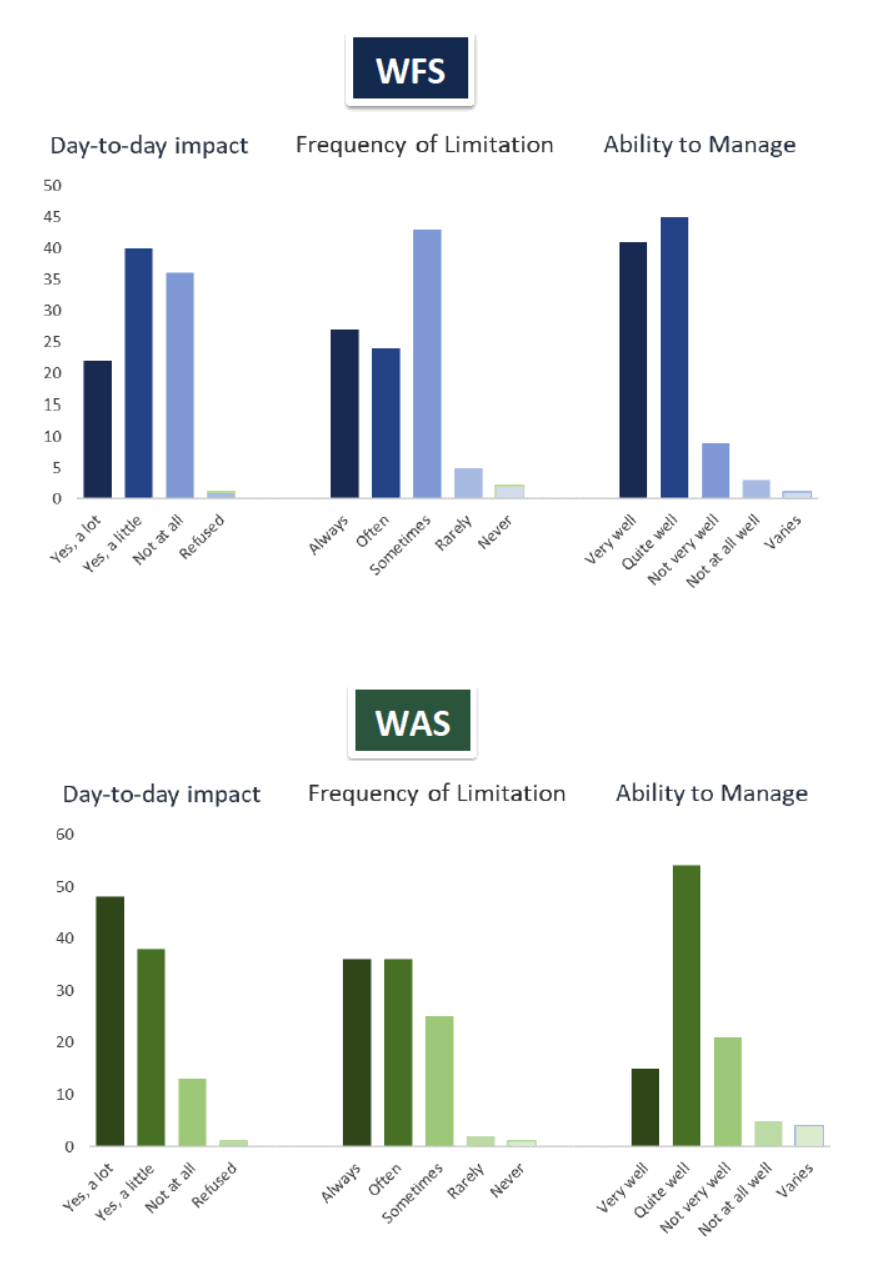
Source: IFF Research telephone survey of WFS and WAS customers.
G4. Does your health or disability reduce your ability to carry out day-to-day activities? / G5. How often does your health condition or disability limit the amount or kind of activities that you can do? / G6. Overall, how well would you say you are able to manage your health condition or disability on a day to day basis? Base: WFS (n=417), WFS condition limits (N=279), WAS (n=174), WAS condition limits (N=150)
Service Participation
At the time of the wave 2 survey, 12% of WFS customers reported that they were still receiving support. Given the 12 month duration of the service and the timing of the fieldwork, this group were likely to be in their final weeks of participation. Of those WFS customers no longer receiving support, more than half (54%) stopped receiving support over 10 months before taking part in the wave 2 survey, 14% 7-9 months before and 18% 4-6 months before.
Some 17% of WAS customers reported that they were still receiving support. (WAS MIS data drawn on 1 November 2018 reports 42% of starts still in support). This reflects the impact of time on a cohort who started WAS between April and end October 2017. A customer joining the service at the end of October 2017 would have used their 12 months of support by the time of the Phase 2 survey and only those who had moved into employment would be receiving post-employment support.
Of those WAS customers no longer receiving support; around a third (35%) stopped receiving support over 10 months previously, 12% 7-9 months ago and 31% 4-6 months ago. Figure 2.2 (continued overleaf) details the proportion of each service still receiving support and when those no longer receiving support stopped.
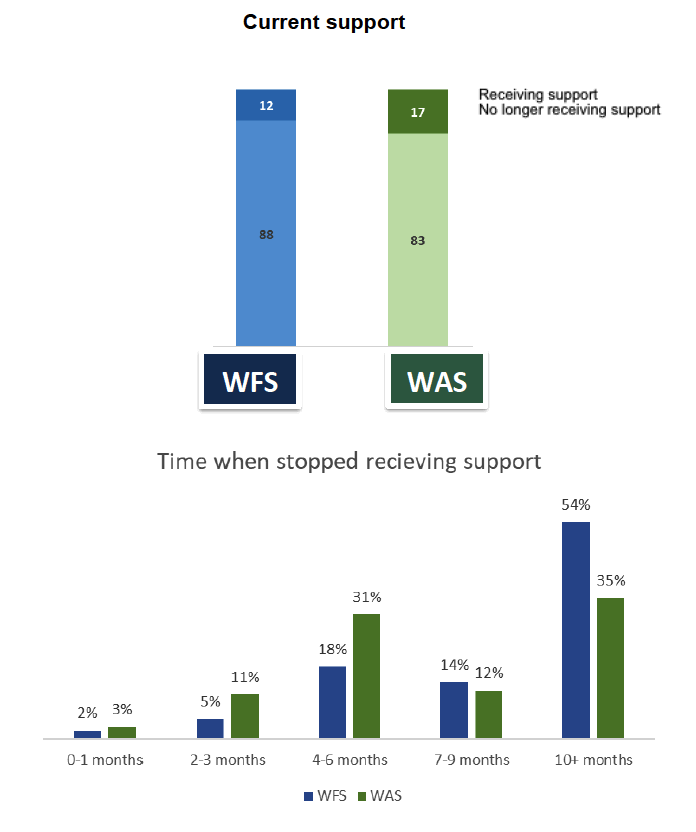
Source: IFF Research telephone survey of WFS and WAS customers.
D1. Are you currently receiving support from the WFS/WAS service to help you move into employment? D3. When did you stop receiving this support?
Base: WFS (n=417) WFS not receiving support (n=350), WAS (n=174), WAS not receiving support (n=142).
2.4 Service Outcomes
Introduction
This section sets out the survey customers' views on the impact of WFS and WAS on their employment, health and wider wellbeing. Respondents' views were sought on whether their experience of support had altered their attitudes to work and health and their reasons for not continuing to seek support to enter into employment.
Employment
Customers were asked how they would best describe what they were doing at the point of being surveyed. Customers were classified as working if they were self-employed or employed. Those who were not working and claiming benefit, or not working and not claiming benefit were summarised as not working.
The working status of customers at wave 1, between 3 and 9 months after joining the service, and wave 2, between 15 and 18 months after joining the service, is shown in figure 3.1 below. A small proportion of participants (WFS 5%, WAS 3%) were classed as 'other', including those about to start work or in education.
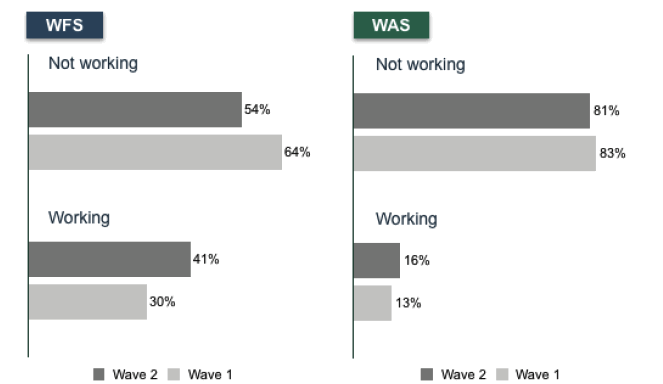
Source: IFF Research telephone survey of WFS and WAS customers
A1 Which of the following best describes what you are doing at the moment? Wave 1 Base: WFS (n=499), WAS (n=201) Wave 2 Base: WFS (n=417, WAS (n=174).
Among WFS customers:
- Forty-one per cent were in work in wave 2, an increase from 30% in wave 1. The proportion not working decreased from 64% in wave 1 to 54% in wave 2. This suggests that Providers were progressively able to support people into better outcomes over time.
- More than half (51%) of those aged 16 – 34 were in work in wave 2.
- Those who reported no disabilities (58%) were more likely than those with physical disability (37%) or mental health issues (33%) to be working.
Among WAS customers:
- Similar proportions of customers were in work at wave 1 (13%) and wave 2 (16%). A similar amount of customers were not working at both wave 1 (83%) and wave 2 (81%). While this demonstrates some improvement over time, the on-going challenges of supporting people onto the service may have played a part in limiting provider progression.
- Female WAS customers were slightly more successful in securing short job outcomes. Those aged 25-49 are proportionately more likely to secure a short job outcome. Younger people 18-24 and older workers over 50 were less likely according to WAS MIS data.
- MIS data on the health conditions reported by WAS customer who achieved a short job outcome are very similar to those of all starts on the service.
- Similarly, the number of health conditions reported by WAS customers who secured a short job outcome are also very similar to that reported by all WAS customers. This is somewhat contrary to expectations where customers with fewer health conditions tend to have higher job entry rates.
Impact of support on moving into or remaining in work
Customers who were in work when they answered the wave 2 survey generally agreed that the support they had received helped them both move into work and remain in work. Customers' views of the helpfulness of the support, shown on a five point scale from one (not at all) to five (a great deal) are shown in figure 3.2 overleaf.
Findings relating to WAS customers who were in work should be treated with caution as the base size is small.
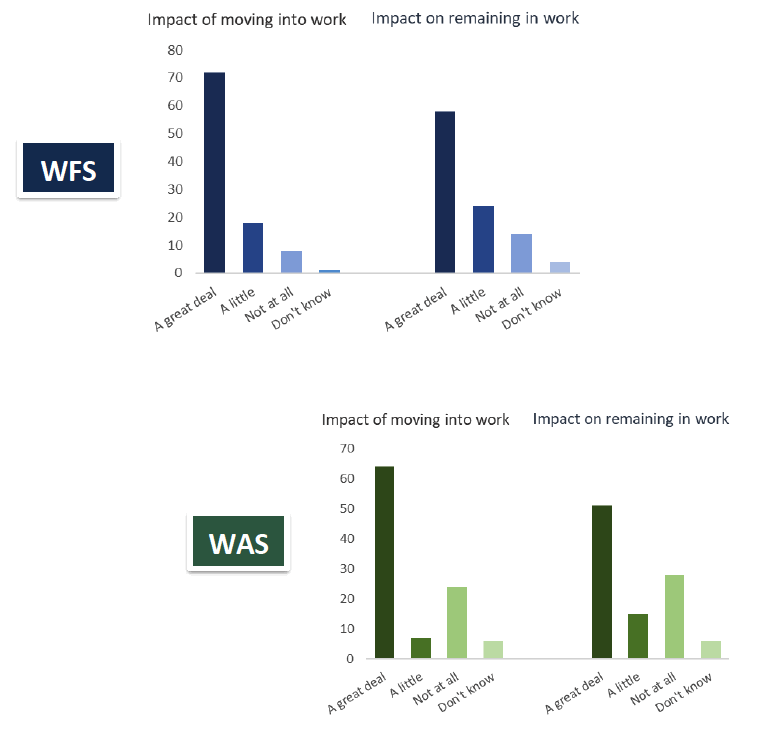
Source: IFF Research telephone survey of WFS and WAS customers
F2 To what extent do you think the advice and support you received helped you move into work? Base: WFS (n=162), WAS (n=33)
F3 To what extent do you think the advice and support you received helped you to remain in work? Base: WFS (n=162), WAS (n=30)
Amongst WFS customers:
- Over half (55%) of customers felt that the support they had received had helped them 'a great deal' in moving into work, with over two thirds (69%) agreeing to some extent (a score of four or five out of five). There was a similar strength of feeling about the support to remain in work (49% felt it helped a great deal, 69% to some extent).
- Generally, older customers were more likely to be positive about the support, with those aged over 45 more likely than those aged under 45 to answer that the support helped them 'a great deal' in moving into work.
- Female customers were also generally more positive than male customers about the impact of the support received through the WFS services.
Views amongst WAS customers were more polarised:
- Over half (56%) of customers in work felt that the advice and support had helped them 'a great deal' move into work. However, a fifth (21%) felt that the advice and support they had received had not helped them move into work at all.
- Just under half (49%) of customers felt that the advice and support they received helped them to remain in work a great deal, whilst conversely, over a quarter (27%) said that it had not helped them to remain in work at all.
Customer M is male, age 45-54. Entered work post-service.
Customer M is currently self-employed, as a landscape gardener and van driving work. Hours vary between 20-45 pw. He set up this business in January 2018, and has been growing the business during the year.
He left his previous employment in retail in May 2017, following a period of absence due to ill health. He was suffering from stress and anxiety, which he felt was connected to shift and weekend work. He had some savings and did not want to claim benefits. He approached a mental health charity for support when he became unemployed. The counsellor told him he should be claiming benefits and encouraged him to register with JCP. He was registered with JCP for two months, and deregistered when JCP wanted him to attend meetings with occupational health specialists in Glasgow. He comments that the thought of meetings was quite stressful for him.
At that point he decided to be a stay at home dad, combined with self-employment. At the end of 2017, the mental health counsellor referred him to the provider for advice on setting up on a self-employed basis. He feels he benefitted a great deal from the one-to-one support he received from the provider. He was able to meet the advisor quickly, who worked with him on the stages of becoming self-employed. This included preparing a business plan, setting up an accounting system, registering with HMRC.
Customer M feels that this was extremely helpful, as he had no experience of any of this paperwork or procedures. He feels that his business start-up would have been much slower without the advice from the provider. Tax has been the biggest challenge and worry, and without this advice he would have struggled to get it right and plan ahead. He feels it was good to know that the advisor was involved and available for queries. The advisor also helped him to apply for funding for equipment necessary for his business.
He feels that he was in control of the process for becoming self-employed, and that he was supported in his ambition, rather than be directed to vacancies for the type of job he had previously held.
Customer M feels that his health is better than it was when he left his previous employer, although being self-employed is not as easy as he first thought. The unpredictability of the hours has taken some getting used to. He hopes that he will be able to increase his hours, to give a more stable income.
Expectations and motivations for future employment for those not currently in work
Customers not in employment were asked about how they felt about returning to work currently, whether they would like to return to work in the future and at what stage in the future they might be able to return to work.
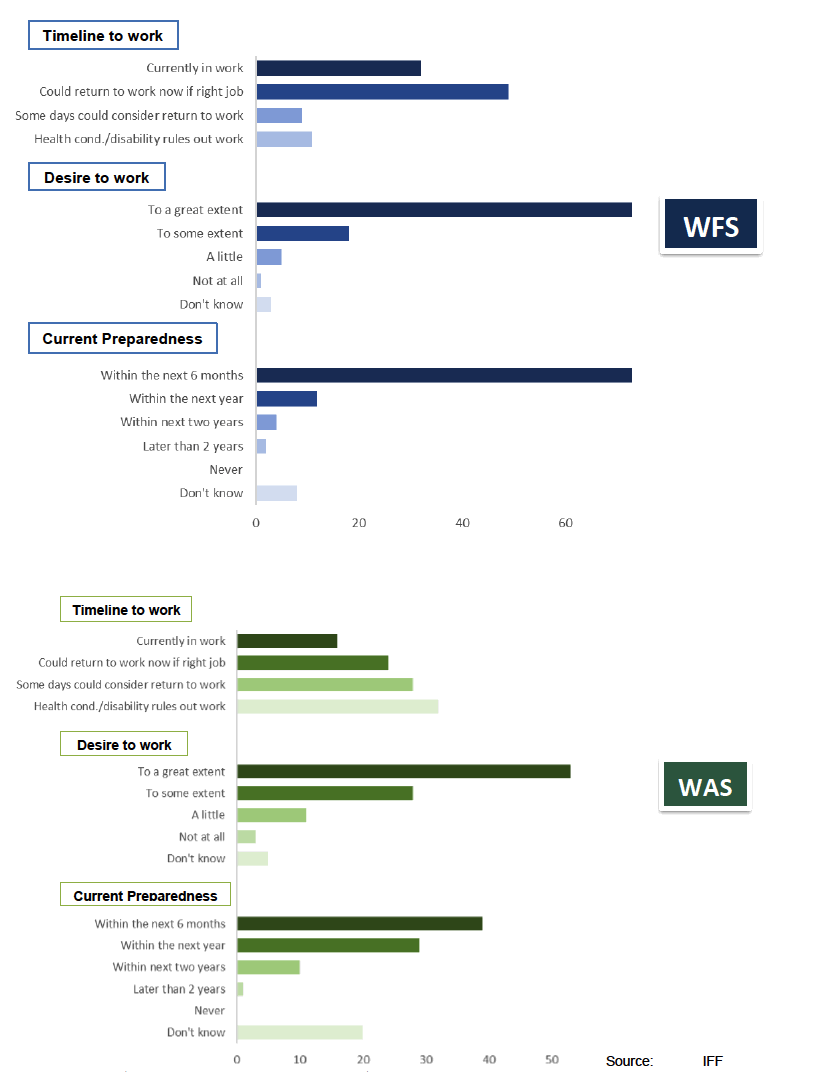
Source: IFF Research telephone survey of WFS and WAS customers
E1 Which of the following is closest to how you feel about returning to work? / E2 To what extent would you like to return to work in the future? / E3 At what stage in the future do you think you will be able to work? Base: WFS (n=417), WAS (n=174), WFS not currently employed (n=255). WAS not currently employed (n=141)
Among WFS customers:
- Around three quarters (73%) of customers were either working or could return to work now if there was a job available. Around one in six (16%) felt that their health condition or disability ruled out work.
- 85% of customers would like to return to work in the future to some or a great extent.
- Almost three quarters (73%) thought that they would be able to return to work within the next year.
Compared to responses from wave 1, there has been a significant reduction in the percentage of WFS customers who are out of work but feel that they ready for employment (from 71% in wave 1 to 56% in wave 2) and may reflect the time elapsed since customers were in receipt of support.
The proportion of those expressing a desire to work has also fallen but remains at a high rate (from 91% in wave to 85% in wave 2). Similarly, the proportion who consider that they would be able to return to work within a year has fallen from (83% in wave 1 to 73% in wave 2). This fall is largely accounted for by those who say they do not know when they will be ready to return to work.
Customer C is male, age 35-44. Entered work post-service.
Customer C is not currently working, but he is about to start a 12-week trial as a labourer in a factory. This has been arranged through an agency, and he hopes to be offered full time employment. He expects that he will be working around 46 hours pw.
He previously worked as a builder, and had been out of work for 13 years, due to a dislocated knee. The Jobcentre referred him to the provider, who helped with the capability for work assessment. His health improved gradually, with some flare ups, and he has been much better for about 18 months. He signed up with the provider as a means to find employment. He has tried every avenue, including volunteering, and also had a job which only lasted a month.
The provider helped him prepare for interview and with the cost of clothes for interview and work. The client believes he benefitted from regular meetings with the provider. Specifically, the provider helped write his CV, and with using the computer. The client comments that he is not good with computer skills.
He sees getting back into work as a priority. He is pleased that the provider put him in touch with the agency, and is looking forward to starting work. He thinks he needs advice from the provider about universal credit. He is not sure if the provider had any direct contact with his new employer.
The customer feels better about his life since being involved with this provider and is positive about starting work. He does not have any health concerns about the new job or working hours. The new employer is aware of his previous health condition.
Among WAS customers:
- Thirty-nine per cent of customers were either working or could return to work now if there were a job available. However, 35% felt that their health condition or disability ruled out work.
- Eighty-two per cent of customers would like to return to work in the future to some or a great extent.
- Sixty-two per cent thought that they would be able to return to work within the next year, and a much smaller proportion (5%) said that they felt could never return to work.
WAS customers face significant health barriers that limit their ability to work at present, however this does not affect their desire to work in future; the proportion of WAS customers who expressed a desire to work sometime in the future also remained very high across both waves at over 80%. Responses from WAS customers to the impact of the service on their future employability are very consistent across the two survey waves.
Customer Q is male, age 45-54. Did not start service support.
Customer Q has been unemployed for 12 years, due to significant ill health problems and the need for medical interventions and surgery. His previous work as a machine operator is too heavy for his health problems; he would like to be able to work in IT. He is currently waiting for an operation, after which he expects to return to the Jobcentre.
The Jobcentre referred him to a provider, where he attended a back to work course. He feels he benefitted from support including online courses and a mindfulness course. Although he knew there was no pressure to apply for jobs, he wants a job for 'his own sanity'.
He believes he is not well enough to work full time, yet he would need full time employment to be able to afford losing his current benefits. Health problems continue to be a barrier from securing a job.
Customer Q feels he is in 'a much better place' now than before he attended the course. He feels that the opportunity to get out of the house, meet people and participate lessened his anxiety and depression. He feels that his support worker was very helpful, and it was good to having someone to listen and understand his needs. He continues to communicate with his support worker, although he no longer meets him.
How has support changed customers' outlook?
Customers were asked about the extent to which they agreed with a range of statements about both their abilities to search for work and attitudes related to work. Figure 3.4 (continued overleaf) shows response to statements related to work search support.
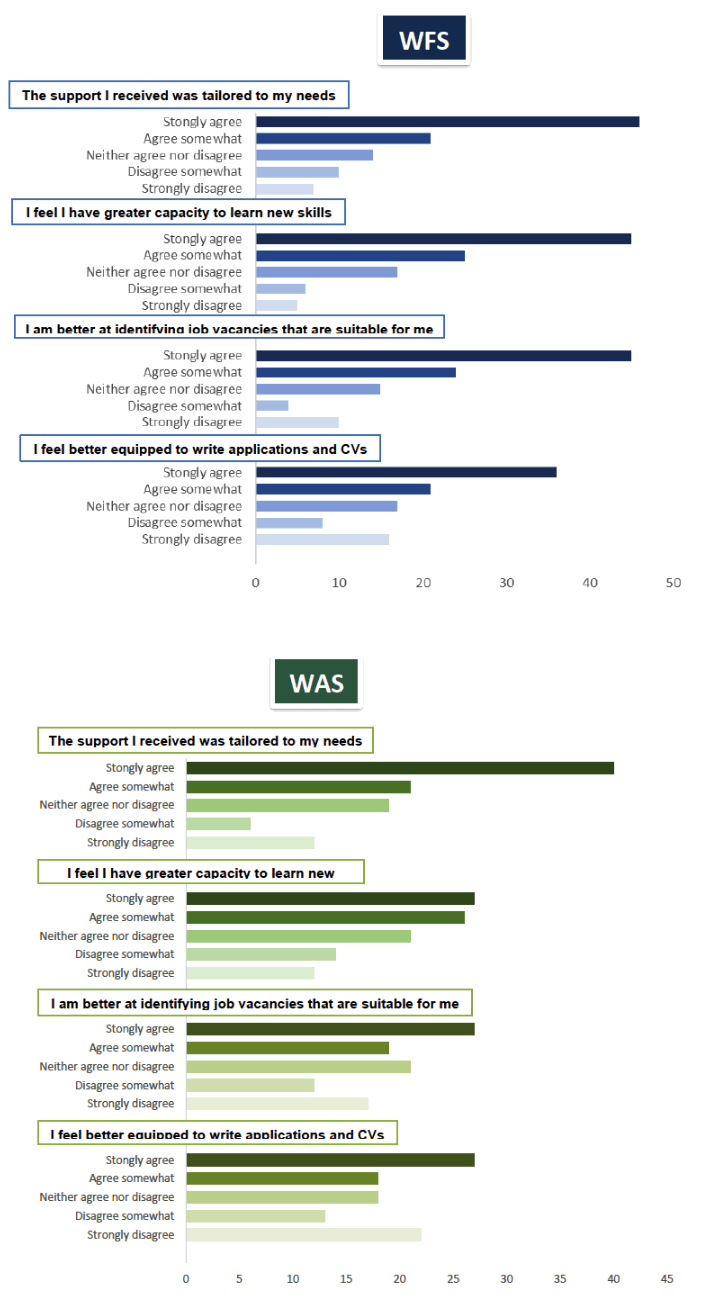
Source: IFF Research telephone survey of WFS and WAS customers
F1 To what extent do you agree with the following statements about the support you received? Base: WFS (n=417), WAS (n=174), WFS not currently employed (n=255). WAS not currently employed (n=141)
Among WFS customers:
- Two thirds (67%) agreed that the support they received was tailored to their needs, although older respondents (those aged 55 and over) were less likely to agree with this than the other age groups (51%).
- Customers mostly agreed that their abilities to find jobs had improved, with 69% agreeing that they were better able to identify suitable jobs and 70% feeling that they had a greater capacity to learn new skills.
- A smaller proportion of customers felt that they were better equipped to write applications and CVs, with 56% agreeing but almost a quarter (24%) disagreeing.
The same proportion of WFS customers felt that support from Providers was tailored to their needs in both survey waves. However, customers were more likely to report that they were better at identifying job vacancies that were suitable for them an increase to 69% from 59% in wave 1. Customers also reported that they had a greater capacity to learn new skills. This is a new question only asked in wave 2.
Customer L is male, age 45-54. Entered work post-service.
Customer L is currently working 21 hours pw (plus opportunity for overtime), with a permanent contract.
The Jobcentre referred him to the provider so that he could benefit from the additional help provided. He had worked as a carer for over 10 years with his previous employer, but had been off work due to ill health, and then had been unemployed for several weeks. He had developed depression as a result of personal bereavement, which led to a loss of confidence. He felt that working closely with clients in a social care setting, some of whom were very ill, added to his depression. He felt that the depression had crept up on him, and he had also sought medical help from his GP.
Customer L feels that the support from the provider came at a very good time for him, before he went too far down a slippery slope to mental health problems. Working with the counsellor helped to motivate him to return to social care work. He had considered seeking work in retail, to ensure that his depression did not return. However, the one-to-one meetings with the counsellor encouraged him to apply for jobs which would use his qualifications and experience. The counsellor emphasised the positives and helped him to stay focused on finding the route back to work.
He feels lucky to have had the counsellor for emotional support and help build his confidence. On a practical level, he feels that the support in improving his interview skills and CV has been invaluable. He feels that the way in which the advisor spent extra time with him on the day before his job interview was really helpful. The advisor also encouraged him to let the employer know about his previous health problem, as this explains his period of unemployment. The employer is fine with this, as they are aware why the depression started.
The provider has not had any direct contact with the employer. Customer L knows that he could have contacted the provider about employment issues, although he has not needed this support.
Customer L feels that his new job is having a positive impact on his health. His employer has provided training, and he feels ready for the new challenge. He now works with hospital discharge patients, where his involvement is on a short-term basis. There is lots of job satisfaction, and he feels appreciated by his clients. He comments that there may be opportunities for progression because of the nature of his employer.
Customer L comments that he feels good since his involvement with the provider; he no longer suffers from depression, and has started a new job using his knowledge and skills.
Customer G is male, age 45-54. Did not start service support.
Customer G has been unemployed for over 20 years. He has been classed as having physical and mental disabilities since he left school. He worked as a landscape gardener and builder, over a 10-year period. He has City & Guilds Level 1 and 2 in Horticulture and Landscaping.
He was referred to the provider because he felt that the Jobcentre could not help him because of his disability. He would like to return to employment but feels that unfortunate family circumstances have led to a deterioration in his mental health.
He feels that his support worker has helped him a lot, in particular to get a medical diagnosis and help him to understand his situation. The client feels that the support is really good, especially the counselling, and the way in which the support is in stages. As a result of this counselling, he now has a medical diagnosis, and has been prescribed medication, which is helping him considerably. He sees his support worker on a weekly basis in their office. He is also able to contact her by phone if he is feeling a lot of pressure.
The support worker has explained to him what might happen next, and how he will progress through stages at different times. Customer G comments that he feels happier now, knowing that there is someone who knows him, and who treats him with respect. He feels that this service is great and that it helps a lot of people.
Among WAS customers:
- The majority of customers agreed that the support they received was tailored to their needs (61%).
- Customers were less positive about other impacts on work search tasks and attitudes. Around half agreed that they had a greater capacity to learn new skills (51%), with 45% feeling that they were better equipped to write applications and CVs or better at identifying job vacancies.
Compared to wave 1, WAS customer responses were not significantly different in wave 2.
Customer S is employed as a part time cleaner with a permanent contract.
When she first came into contact with the provider, she had been unemployed for five years. She had been suffering with mental health problems and depression. Her health improved, and she decided to find employment.
She feels that her support worker was 'amazing'; she let her progress at her own pace and was very pleasant and helpful.
Her support worker asked her what type of job she would really like to do. Customer S had a range of work experience, including work as a presser in a factory. She decided to set up her own ironing business in October 2017. The provider helped financially with the cost of buying an iron and other equipment. Unfortunately, the client was unable to find sufficient business to be able to continue. She continued to see the support worker and they agreed she should look for other employment.
The support worker identified a cleaning job and set up an interview with the employer. Customer S did not have any health concerns about taking this job. She feels that her health has improved and that she does not have any barriers to staying employed. She has not needed the provider to resolve any issues at work, although her support worker has kept in touch.
The client is very happy with her job and employer. She feels that she could not work more hours, because of the physical impact. She feels delighted to be in work, getting out of the house, and having an income to pay the bills. She says she definitely feels better with her life since her involvement with the provider, 'being negative doesn't get you anywhere'.
Among WFS customers:
- Across statements addressing confidence related to work, the majority of customers reported improvements. For example, around two thirds reported more confidence in their ability to get a job (64%) or in disclosing their health condition while applying for jobs (64%). A similar proportion reported that they were more confident that they could take a job and it would not harm their health (65%).
- Additionally, customers voiced increased positivity in their outlook more generally. Over two thirds (67%) felt that they were more positive or hopeful about the future and 60% agreed that their personal and job ambitions had increased.
For the two questions asked in both waves, WFS customers were also much more likely to say that they were now more confident disclosing their health condition to prospective employers when applying for a job (increasing from 55% in wave 1 to 66% in wave 2) and they were also less likely to disagree that they are more confident they could take a job and it won't harm their health (20% in wave 1 compared with 15% in wave 2).
Figure 3.5 (overleaf) shows levels of agreement with statements relating to motivations and confidence related to job search task.
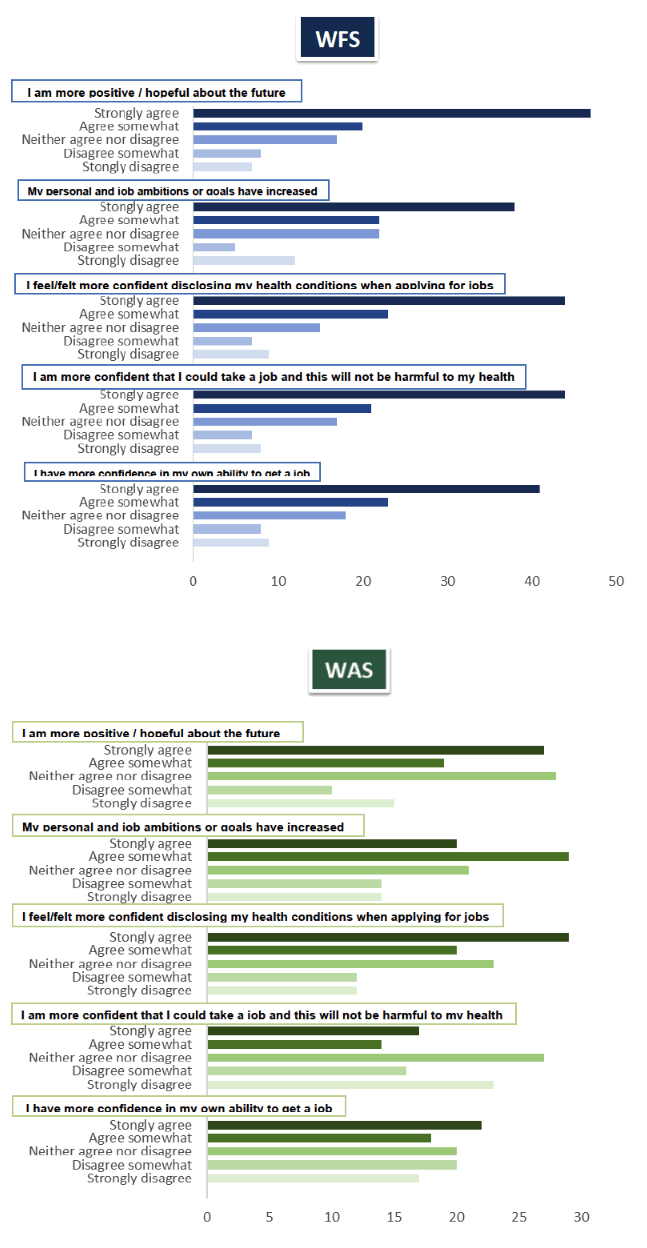
Source: IFF Research telephone survey of WFS and WAS customers
F1 To what extent do you agree or disagree with the following statemetns about the support you received? Base: WFS (n=417), WAS (n=174)
Among WAS customers:
- Customers held a mix of views with regards to changes in motivations and confidence. Whilst three in ten (31%) agreed that they were more confident taking a job without it being harmful to their health, 39% disagreed.
- Similarly, whilst 40% agreed that they had more confidence in their own ability to get a job, an equal proportion disagreed (38%).
- Around half of WAS customers felt that their outlook had improved. However, a quarter disagreed that they were more positive or hopeful about the future (25%) and 28% felt that their personal and job ambitions had not increased (28%).
Compared to the survey results from wave 1, the proportion of WAS customers who felt confident that they could take a job and it would not be harmful to their health was lower at 31% in wave 2 (cf 41% wave 1). Where equivalent questions have been asked across the two surveys, there is a sense that WAS customers are somewhat less optimistic than in wave 1.
Customer I is female, age 55-64. Entered work post-service.
Customer I is employed part time as a cleaner. She had been out of work for around two years when the Jobcentre referred her to the provider. Her health had improved and she was keen to return to work.
She had previously worked as a full-time carer but left this job when she hurt herself at work. Her support worker was very encouraging about looking for work and helped her find vacancies in care work. The participant felt that the range of support from the provider was very good. She benefitted from help to use computers for job searches, interview practice, and participating in group forums. She saw different staff members for different aspects of support. The staff helped her by making phone calls on her behalf, and by completing paperwork with her. Her support worker identified other ways to help which she was not aware of, for example by helping her obtain a refund from the gas company.
Using the provider support, she was offered a job with a care agency, but it was at a different location from where she applied, with difficult travel and shift work for her. This made her think about other work options, and she then applied for a cleaning job, with regular hours. The provider helped sort out the paperwork but did not need to make direct contact with this employer.
She feels that she has also received fantastic support from with respect to housing. The provider helped her successfully apply for a move from an upstairs flat to a small house.
She does not have any concerns about the impact of work on her health and wants to increase her working hours. She hopes to be offered an additional cleaning job, bringing her total to 25 hours pw. She is not sure how much the housing benefit will be reduced as a result of increased income.
Since starting work, Customer I has not needed any employment support from the provider. However, she feels that she can contact them at any time for advice.
She feels much happier now than before she became involved with the provider and is very appreciative of the support she received. She feels that life is better now; she is in work and has a new house.
The majority of those who were in work were very positive about their experiences of work, shown in figure 3.6 overleaf.
Among WFS customers:
- Of those who were in work, 85% agreed that they felt more motivated, 79% agreed that their financial situation had improved and 76% felt that they were more confident talking to their employer about their support needs.
- Reassuringly for the outcomes of the service, two thirds agreed that working had improved their health condition (66%).
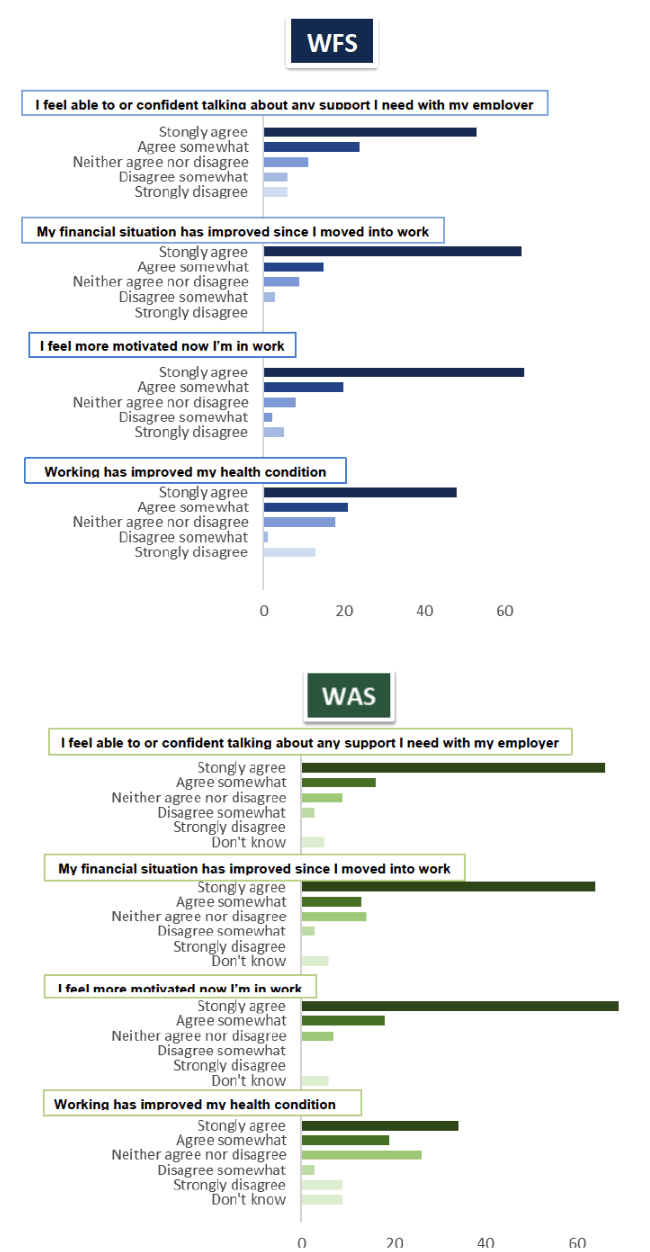
Source:
IFF Research telephone survey of WFS and WAS customers
F1 To what extent do you agree or disagree with the following statements about the support you received? Base: WFS (n=417), WAS (n=174)
Among WAS customers:
- WAS customers were positive about the impacts of working. Of those who were in work, most agreed that they felt more motivated (87%), their financial situation had improved (77%) and they were more confident in talking to their employer about their support needs.
- More than half (53%) agreed that working had improved their health condition.
Customer D is female, age 55-64. Entered work post-service.
In recent years, due to a major change in family circumstances, she developed severe depression and anxiety. She wanted to return employment and was referred to the provider by the Jobcentre. She had worked in a professional role but felt that her skills were not up to date, which together with her health problems and location outside London, were major barriers to finding a job.
The Jobcentre initially referred her to a service for people with barriers to work, after which she moved to the current service with this provider. The support worker worked closely with her and together they identified options for setting up a business. He put her in touch with a business advisor from another local organisation, who provided practical help with setting up a business bank account, and grant applications.
The support worker visited her at home, fortnightly in the early stages of the support, with infrequent communication now that she has set up both businesses. She feels that the provider provided emotional support and made her realise that she was just as capable as anyone else. She also feels that one of the strengths of this support was that she took small steps, which was necessary given her health and family circumstances.
Client D is very appreciative of the grants she was awarded to assist with the business set up. She feels that returning to work has helped her recovery. The businesses have built her self-esteem and confidence, provided a focus and a sense of achievement. She thinks that it will be possible to extend both businesses in the longer term. Overall, work is having a very positive effect on her health. She says that she feels 100% better since she became involved with the provider. She has done a lot for herself as well, but this support has helped her to change direction and reinvent herself.
2.5 Customer Attitudes towards health and work
Customers who were not in work were also asked about their attitudes towards returning to work (figure 3.7 overleaf).
Among WFS customers:
- Customers were divided in their views about where employers could accommodate their health needs with over half agreeing (53%), although a quarter disagreed (25%). Related to this,40% of customers agreed that they knew of many jobs that they could do with their health condition / disability, but 30% disagreed with this statement, with the remainder unsure.
- The results were similarly mixed regarding customers' worries and anxieties. A broadly equal proportion of customers agreed (37%) and disagreed (34%) that they were worried that people wouldn't employ them due to their health condition and similar numbers of customers also agreed (40%) and disagreed (41%) that the idea of working made them anxious.
- Just over a third (36%) agreed that they were worried working could make their health condition worse and one in five (18%) felt that they needed better social care support to enable them to work.
Agreement with these statements was broadly similar to wave 2 across WFS customer groups, with the exception of 'I am worried that working could make my health condition worse', where there has been a positive shift in opinion among these customers. In wave 1, 48% agreed that they were worried about this, this decreased to 36% in wave 2.
Among WAS customers:
- Generally, customers felt considerable levels of concern about the relationship between their health and work. While two fifths (40%) of customers felt that employers could accommodate their health needs, almost three in ten (29%) disagreed. Only a quarter (25%) said that they knew of many jobs they could do with their health condition, and two-fifths (39%) said that they did not.
- The majority agreed that they were worried people wouldn't employ them due to their health condition (64%), and that the idea of working made them feel anxious (56%).
- Around a fifth (21%) agreed that they needed better social care support to enable them to work, with around half (49%) disagreeing with this.
In comparison with wave 1, there were no significant differences in the responses of WAS customers.
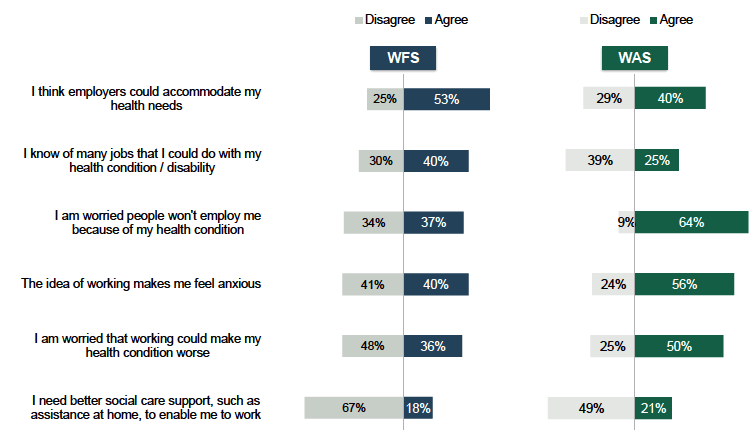
Customer R is male, age 25-35. Entered work post-service.
Customer R is currently unemployed and claiming ESA. When he joined the service, he had been unemployed for 3 years. He was referred by Jobcentre, and was wanting to get back into work. He has mental health problems and wanted to try anything which would help him. He has a science degree but his ambition is work as a software developer. He has trained himself in these skills.
The provider helped him get ready to apply for a job by helping him write a CV, mock interviews, etc. He feels that his support worker was very helpful. He successfully applied for a job and started work. The provider helped with travel expenses and the cost of interview clothes.
The job was permanent, full time, and paid the living wage. Since losing this job after 9 months, he has been actively looking for work and applied for 12 jobs last week.
Customer R is seeing a psychiatrist and is hoping that his mental health problems will improve. He feels he is now better able to manage his health condition, as new medication is helping him. Overall, he does not feel better with his life and circumstances since engaging with the service.
Customer A is female, age 45-54. Entered work post-service.
Customer A is working as a carer, providing palliative support to over 20 clients in the community. This is a permanent position, with long working hours (40-100 pw, including night shifts).
Prior to receiving support from the provider, she had been out of the workforce due to her own ill health, and subsequently whilst she cared for an elderly relative.
When she wanted to return to employment, she registered with the Jobcentre, and subsequently with a provider. She attended an open day and was offered a job with a call centre. She decided not to accept this job because she does not drive, and the location required 2 hours each way on public transport.
The client decided that she would prefer to work in a caring role and was successful in applying to a care agency, with support from the provider. She describes the support from the provider as 'amazing', and 'they were incredibly helpful'. Whilst looking for work, she had regular communication with a support worker. She found the group sessions on interviews skills, and techniques very helpful. Her support worker also collected her from home, drove her to the interview, gave her advice, and drove her home afterwards. He did not sit in on the interview.
The provider also helped her with bus fares for attending interviews, and with cost of buying uniform for her job. She feels that this level of support could not have been provided by the Jobcentre, and that she 'couldn't fault the provider at all'.
Her employer is aware of her long-term health condition and knows that she needs a medical appointment every 8 weeks. She has recently told her employer that she wants to cease night shifts (double shifts), partly due to her health. She believes that the employer will agree. She does not see any possibility of progression to a supervisory role, because she does not have a driving license. However, she is currently working towards Level 3 in care work.
She believes that her job is good for her health condition, as walking between clients help keep her mobile. She comments that her life is 'without a doubt' better since she has been involved with this provider.
2.6 Barriers to work
Customers were asked about the barriers they faced that prevented them from working. For many, their health condition remained the most significant factor in finding employment.
Among WFS customers:
- Over half (51%) of customers said that their health condition or disability makes it difficult for them to work. Around a quarter (24%) reported that not having the right qualifications, skills or experience was preventing them from working.
- A further 14% felt that they may find it difficult to travel to work, and 9% felt that there were not many suitable jobs in their local areas or were worried people wouldn't employ them due to age.
Compared to responses for wave 1, the proportion who reported difficulties in travel to work more than doubled, but from a low base (6% in wave 1 compared to 14% in wave 2).
While there have been significant differences in the proportion of customers who report that their health condition or disability prevents them from working between waves 1 and 2, this is due to changes in the questions included in each survey. There were no other significant differences across survey waves for these responses.
Among WAS customers:
- Three quarters (75%) of customers reported that their health condition or disability makes it difficult for them to work.
- The next most commonly selected barrier to work was not having the right qualifications, skills or experience (14%), followed by finding it difficult to travel to work (8%).
There are no significant differences between waves for WAS customers.
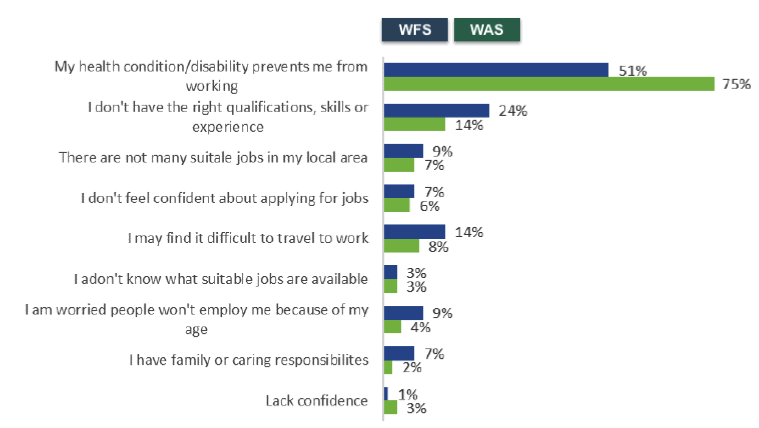
Source: IFF Research telephone survey of WFS and WAS customers
E5. What would you say are the main issues or barriers preventing you from working? Responses with 2% or less are not shown. Base: those not currently in employment - WFS (n=255), WAS (n=141)
Customer N is male, age 35-44. Did receive support from provider but dropped out early.
Customer N is currently unemployed and claiming universal credit and PIP. He has had mental health problems all his life. He has difficulty in coping with busy places, and in communicating with people and would not normally speak to people who he does not know on the phone. He has previously been in receipt of ESA.
He had some support from a provider but he feels that his CV is fine, and he is capable of doing his own internet searches for vacancies. He saw the provider on a regular basis, where he was told to continue to search for work. The provider offered to help him, but the client felt this was a waste of time for both of them. He had a short period of agency work, as a driver's mate after he left the provider but not worked since.
His last permanent job was a long time ago. He does not have a driving license, which makes it difficult to apply for some jobs due to their location. He feels that the cost of learning to drive is a barrier; each time he has sufficient savings he needs to use the savings for something urgent.
He continues to apply for jobs, but they are usually temporary and seasonal, with agencies. Temporary short periods of work lead to problems in receiving benefits, especially if the work pays minimum wage. He feels that permanent jobs are 'like gold dust'.
Customer N feels that it is getting easier to tell employers about his mental health problems, as there is more general awareness, which make this more acceptable.
Customer T is male, age 35-44. Did not start service support.
Customer T has been unemployed for 6 years, due to mobility problems. Prior to that he worked for [social enterprise] for 19 years.
He was referred to the provider by the Jobcentre. He feels he was pushed into starting the service at a time when he was not fit for work. He is currently waiting for an operation which he hopes will improve his mobility.
He participated in the service for around 12 months. He developed a CV and had help with job searches and interview coaching techniques. He feels that the weekly sessions were more relaxed than going to the Jobcentre. He applied for several jobs but was not offered an interview. He feels that the health reviews and physiotherapy have helped a bit. He is extremely worried that doing physical work like he used to would have an adverse impact on his health.
He is currently volunteering for a charity shop but would rather have a similar job which would give him some income. He feels he 'can get by' with his health condition at the moment.
He would like to be able to work in retail after his operation and thinks that he will be fit to work on a checkout.
Reasons for leaving the service
Customers were asked why they left the service (figure 3.9 overleaf).
Among WFS customers:
- Thirty-nine per cent of those who had left the WFS service by the time of the Wave 2 interview left because they had found work. A further quarter (26%) left when the service came to end. One in ten (11%) left because they found the service was not relevant to their needs.
- Men were more likely to leave due to finding work (46%) than women (26%).
Compared with wave 1, WFS customers were more likely to report that they had left the service because they found work (25% in wave 1 compared to 39% in wave 2). Wave 1 and wave 2 responses were very similar across all other reasons.
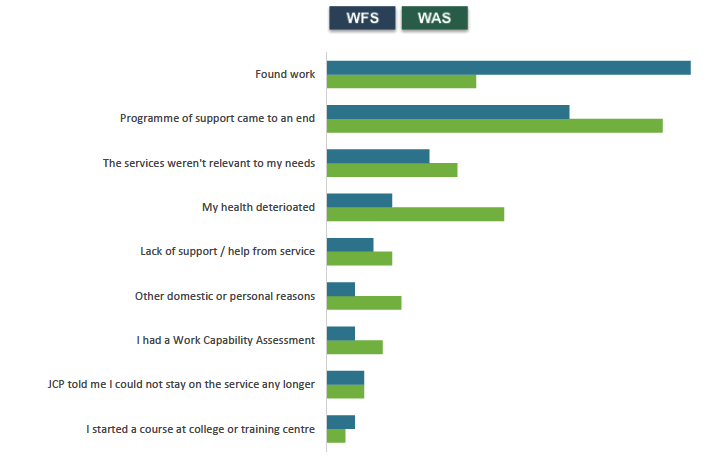
Source: IFF Research telephone survey of WFS and WAS customers
D4. Why did you leave the support service? Responses with 2% or less are not shown. Base: all respondents no longer receiving support WFS (n=350), WAS (n=142)
Among WAS customers:
- The most common reason for leaving the service was that the support came to an end (36%). Around one in six (16%) left the service as they had found work, and one in seven (14%) left as the service was not relevant to their needs.
For WAS customers, differences in responses between survey waves reflect the longer duration customers were in receipt of support by the time of wave 2 fieldwork.[12] Key differences in the reasons provided are:
- Support came to an end for just over a third (36%) compared to 4% in wave 1
- Fewer customers reported that they left due to a lack of support fell from 21% in wave 1 to 7% in wave 2.
Contact
Email: robert.taylor@gov.scot
There is a problem
Thanks for your feedback